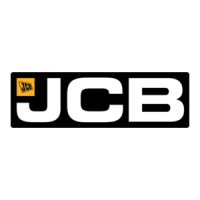13 - 1
Section E
Hydraulics
9803/6400
Section E
13 - 1
Issue 2*
Hydraulic Pump JS200, JS240
Operation
The rotary group consists of the drive shaft F (111), cylinder rod (141), piston shoe (151, 152), press plate (153), spherical bush
(156), spacer (158) and cylinder spring (157). The drive shaft is supported on both sides by the bearings (123, 124). The shoe
is caulked on the piston and forms the spherical coupler, and because it slides slightly on the shoe plate (211), it has a pocket
to balance the oil pressure. The subgroup, which is made up of the piston and shoe is held down on the shoe plate by the
cylinder spring through the press plate and spherical bush. In the same way, the cylinder block is held down on the valve plate
(313) by the cylinder spring.
The swash plate group consists of the swash plate (212), shoe plate (211), swash plate support (251) bush (214) pin (531) and
servo piston (532). The swash plate is supported by the swash plate support at the cylindrical part formed by the side opposite
to the shoe sliding surface. The oil pressure controlled by the regulator is guided to the hydraulic cavities on both sides of the
servo piston which moves the servo piston to the left and right, causing the swash plate, through the spherical portion of the pin,
to press on the swash plate support and changes the angle (a).
The valve cover group is comprises the valve block (312), valve plate (313) and valve plate pin (885). The valve plate, which
has two oval shaped ports, is on the valve block and delivers oil to and recovers oil from the cylinder block. The oil directed by
the valve plate flows through the valve block and is connected to the outer piping.
When the drive shaft is driven by the engine, the cylinder block rotates simultaneously with the spline coupling. When the swash
plate is leaning, the piston in the cylinder block rotates simultaneously with the cylinder block and causes reciprocal motion
relative to the cylinder.
Therefore, during one rotation, the piston moves away from the valve plate for 180° (enough for oil suction) and approaches the
valve plate for the remaining 180°. When the swash plate leaning angle is at the minimum 5° the piston does not stroke and
does not deliver oil.
*

